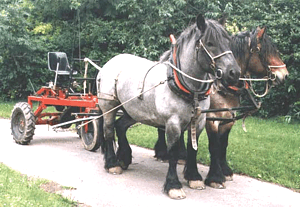
HORSES OF THE WORLD
| ARDENNAIS
Origin: |
 Photo supplied by Rural Heritage, USA © |
History:
The Ardennais was named after the mountainous region on the French-Belgian
border where it originated many centuries ago. In their writings the Roman emperor Julius
Caesar and the Greek historian Herodotus praised horses from the north east of France, who
were than known as Gaul, for their strength and stamina.
Until the 19th century the Ardennais was less massive and was used for draught work and
for riding. At around 1810 it was crossed with Arabians and later with Thoroughbred,
Percheron and Boulonnais which was soon abandoned as it did not improve the breed. The
breeding went back toward heavier horses required for farm and heavy draught work. During
the French Revolution and the Invasion of Russia the stamina and strength of the Ardennais
proved to be invaluable to the military. It was also in great demand as artillery horse in
World War I.
Today there are two other types of Ardennais recognised due to crossing with the Belgian
Draught horse. The Auxois is a larger version of the Ardennais and the Ardennais du Nord
(formerly known as Trait du Nord) is heavier and larger framed.
Characteristics:
massively built
Head: straight profile; low, flat forehead; slightly
prominent eye sockets; large eyes with intelligent, gentle expression; pricked ears; wide,
open nostrils
Neck: well set, medium length, arched
Shoulders: very strong
Body: medium heavy body; deep chest; short back; muscular
loins; wide, rounded hindquarters
Legs: fairly short, strong, muscular limbs
Color: roan, red-roan, iron grey, dark/liver chestnut and bay
are preferred; bay-brown, light chestnut and palomino are permitted; black, dappled grey
and all other colors are not allowed
Height: 15 to 16hh
Temperament: gentle
Qualities: strong, tough, stamina, able to thrive on a
minimum of feed
Today:
The Ardennais can still be found working on the land. Because they are
economical to keep they are popular with farmers of small holdings.
![]()